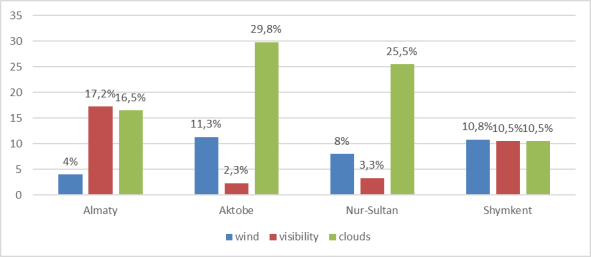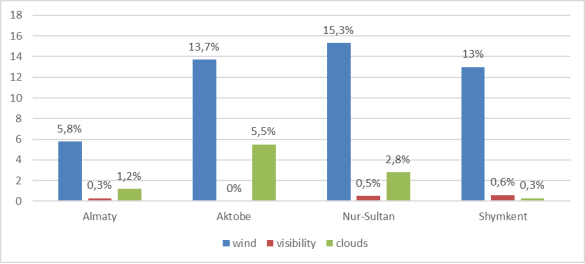Meteorological support of civil aviation flights (MS CAF) — one of the forms of flight support, and the main purpose is to ensure the safety, regularity and efficiency of flights, by providing aircraft courts with authentic meteorological information. The fundamental for the regulation of meteorological support of Civil aviation is the guidance of the World Meteorological Organization (WMO) and ICAO, the rules of meteorological support of civil aviation in Republic of Kazakhstan and other standard governance documents. In Republic of Kazakhstan, meteorological support of civil aviation is attended to the authorized body in the field of civil aviation-meteorological service of RSE “Kazairnavigation”, which includes 4 LGB (Almaty, Nur-Sultan, Aktobe, Shymkent) and 19 aerodrome meteorological bodies (PLC). At the moment, there are a number of problems in the MS CAF, such as: insufficient technical equipment with modern meteorological equipment of aerodrome meteorological authorities; obsolete technical devices of conducting meteorological observations in some aerodromes of the country; the inability to train and improve the skills of meteorologists in other countries; the lack of authentic methods of forecasting weather and hazardous weather for aviation; insufficient coverage of the country's network of meteorological radar-location stations and aerologic stations. The main ways of the improvement of MS CAF should go in several directions at the same time: improving the regulatory framework of MS CAF; development and implementation of modern technical devices of meteorological observations and measurements; development and implementation of automated forecasting systems based on modern numerical methods and forecasting techniques; centralization of forecasting processes and exchange of meteorological information for aircraft flight.
Keywords: aviation weather forecast, flights meteorological support, aerodrome meteorological authority, meteorological tracking authority, meteorological information, dangerous meteorological phenomena.
Civil aviation — aviation used for the purpose of air transportation of population, posts and loading. It is generally subdivided into commercial air transportation, aviation operations, and general aviation assignments.
Nowadays civil aviation is still developing rapidly. It is noticeable not only in increasing the intensity of air traffic from year to year and flying ranges, but also in improving aviation equipment and technical equipment of aerodromes.
A great contribution to the development of civil aviation brings world tourism, which increases the number of international air travel. According to the OAG (international air transportation agency) report for 2018, in nominations of the World's Top 20 Busiest Routes category, concerning the most popular routes, the maximum number of flights is observed between Singapore and Kuala Lumpur. There are 84 flights daily. Moreover, as on the route London-New York almost twice less, there are only 38 departures. In third place in the list of popular destinations is Jakarta — Singapore.
Air transportation in our country, following the results of 2018, Kazakh airlines transported a record number of passengers over the past 5 years — 7.9 million people (in 2017 there were 7.4 million people). Air Transportation is widely thought as the leader in terms of growth among all modes of transport. At the end of 2018, the number of air passengers increased by 6.9 %, while the number of railway and automobile transportation passengers increased by only 1.7 % and 1.3 %, in compliance [1].
The main purpose of this research article is to identify the problems of meteorological support of civil aviation in Republic of Kazakhstan. During considering this issue, there were studied both foreign and domestic materials, and there were used statistical data of meteorological services of RSE «Kazairnavigation».
Results and discussions
The main assignment and purpose of meteorological support for civil aviation is a promotion of safe, regular and efficient flight operations, that is, the preparation and release of meteorological information to notify pilots and other aviation users about the weather conditions that may affect the safety of aircraft. It means that meteorological information is an integral part of the safety mechanism which cannot be overestimated, because the statistics on numbers of accidents in world civil aviation on meteorological conditions indicate that aviation is still depends on the condition of the aerial environment.
Civil aviation in our country has a huge number of problems and deficiencies, and to the main problems of the civil aviation industry, according to the Aviation Administration of Kazakhstan, we can include the following:
1) minimized technical equipment and deterioration of ground infrastructure of airports (50 %);
2) outdated fleet of aircraft;
3) small quantity of operating aerodromes of local air lines;
4) insufficient equipment of aerodromes with accurate approach systems and visual means ensuring operation in difficult meteorological conditions;
5) significant wear of machinery, lighting equipment and power supply equipment, communications;
6) lack of the necessary level of equipment of air transport infrastructure with ground equipment, cargo warehouses and terminals;
7) severe deficiencies in qualified personnel [2].
The gradual solution of foregoing problems will help to bring for industry a new and progressive level.
One of the priority assignments in ensuring flights is still meteorological support of civil aviation. The recommendations of the world meteorological organization (WMO) and ICAO, also the rules of meteorological support of civil aviation, compile the regulation of meteorological support of civil aviation in Republic of Kazakhstan.
The organization of meteorological support of civil aviation in Republic of Kazakhstan is carried out by the authorized body in the field of civil aviation of the Republic of Kazakhstan, which performs the functions of the meteorological authority having jurisdiction [3].
It is generally admitted that for the meteorological support of aviation, that means, for the preparation of the weather forecast, it is necessary to have accurate information about the actually observed state of the atmosphere and its expected variations. Data about actual weather are made available for aviation forecaster, in the form of weather observations at airports and meteorological stations, aerosynoptic materials, satellite data, data from weather radars and data from aircraft. There is a first problem associated with the insufficient number of terrestrial networks of weather stations in our country, which forces forecasters in the preparation of aviation weather forecasts to use the available rare data of terrestrial weather stations, and in their absence, which is common everywhere, rely only on their practical experience and general information about the climate of these regions.
The additional complexity is the fact that the number of aerologic stations in our country consist of only nine, not to mention their complete absence in the territory of East Kazakhstan at the moment. Such situation does not allow to solve qualitatively problems of development of aviation forecasts of weather, there are no enough safe methods to the forecast of dangerous phenomena of weather, and qualitative and quantitative assessment at their forecasting does not always give positive results concerning stability of daily fluctuations of meteorological parameters of the atmosphere and the phenomena [4].
Beyond that, an important role is played by various forms of weather radars, which are designed to detect dangerous for aviation forms of clouds, precipitation zones, visibility deterioration, lightning flashes, hail, strong winds and squalls. The use in operational work of such kind of radars, and also automated meteorological measuring systems (AMIS), as a device of equipping aerodrome meteorological authorities is the standard in world practice, but still remains an acute problem in our country. Nowadays, from more than twenty airports in the Republic, more than half are still forced to use non-automated devices of observation, which is quite sad in the face of XXI century.
Ensuring high authenticity of primary meteorological data is possible due to the development and implementation of modern technical devices of meteorological measurements and observations working on different physical principles, and also their complexation [5, 7].
Additionally, another problem is the direct forecasting, or rather the lack of new methods of forecasting dangerous weather phenomena for aviation. It is safe to say that almost all meteorological services of aerodromes in our country use technology to develop weather forecasts, which are based on manual methods proposed in the middle of 70s of the last century. After so many years, these methods have not been updated and for the most part, they are absolutely not suitable for a particular area of the Republic. Given this, the main content of the work of the forecaster is still a manual analysis of the actual weather maps and prognostic maps, which are compiled and aviation weather forecasts. The quality of meteorological forecasts in this case is largely based on the personal experience and intuition of the forecaster [6]. Besides, it is worth noting that the «manual method» requires a lot of time, and the analysis of the material and the preparation of a qualitative forecast takes up to several hours of painstaking work. For all regions in Republic of Kazakhstan, there aren’t still exact quantitative methods of aviation forecasts.
The preparation of various types of aviation forecasts is based not only on the analysis of actual weather data, but also on the use of numerical forecasts. For the forecasts use mesoscale, global numerical models, etc. For instance, on the basis of global numerical models are constructed prognostic maps of special phenomena for the upper and middle levels (SIGWX FL100–450, SIGWX FL250–630), which are issued by the WPFC (World Zone Forecast Center) London, Washington and Moscow for 4 times a day by fixed periods of 00.00, 06.00, 12.00 and 18.00 UTC and are used to ensure flights performed within a time period ±3 hours from the fixed period specified on a map. In addition, the aviation forecaster has at its disposal advisory information on volcanic ash and tropical cyclones.
Significantly the aviation forecasters are personally responsible for all issued meteorological products, including weather forecasts. And this, on the other hand, means that there is a probability of manifestation on their part of some «conservatism», which leads to the fact that often experts give «reinsurance» forecasts, in other words predict more bad weather than is actually expected, referring to possible dangerous meteorological phenomena [4,8]. In figures 1 and 2 provide data on the frequency (%) of «false alarms» in TAF forecasts for 2018 on wind speed, visibility and height of the lower cloud boundary (CBH) for the aerodromes of Almaty, Aktobe, Nur-Sultan and Shymkent.

Fig. 1. Frequency (%) of false alarms (reinsurance forecasts) in TAF forecasts in cold months (October-March) for 2018.

Fig. 2. Frequency (%) of false alarms (reinsurance forecasts) in TAF forecasts in warm months (October-March) for 2018
While analyzing these diagrams, the so-called «seasonality» catches the eye. For instance, the frequency of reinsurance forecasts for Almaty airport in the winter is much higher than at other aerodromes under consideration. The reason is the geographical location of Almaty airport and its famous «fogginess» in the winter season, which is the cause of a huge number of flight delays and departures to alternate aerodromes. The same situation is developing at Nur-Sultan airport regarding wind speed, and given the fact that the considered meteorological parameters are dangerous for aviation, incorrect forecasting of which can affect the safety of flights, it becomes clear the reason for such a phenomenon as «reinsurance forecast».
The situation with» reinsurance " forecasts cannot be affected by the regularity and safety of civil aviation, so for that reason it would be more appropriate to remove from forecasters imposed on them personal responsibility.
Training of aviation meteorological personnel can be singled out as a separate item. Training of future weather forecasters in our country is still taken over by the only higher educational university in the whole Republic, where sometimes as a teaching material students are still forced to use the literature of the Soviet times, due to the limited amount of fresh training material. Since the definite time, the future forecasters have become unavailable training practice directly at the airports themselves, which deprives them of the opportunity to observe firsthand the process of the aviation forecaster.
Conclusions
For the development and elaboration of meteorological support of civil aviation, it is necessary to perform the following:
– to imply in modern automated technical devices of measuring meteorological parameters of the atmosphere at all aerodromes;
– to improve the legal and regulatory framework;
– to improve the methodology and authenticity of aerologic measurements, to elaborate and implement complex systems of aerologic radiosonde observations [4];
– to develop methods of forecasting dangerous weather phenomena for aviation specifically for a given region;
– preferably to develop and imply in an automated forecasting system based on modern numerical methods and forecasting techniques. The use of automated forecasting systems is widely used in the countries of the European Union, and allows to obtain a sufficiently detailed meteorological forecast, which is based on numerical models of forecasting premised on the specified parameters.
The implantation of modern technical devices at aerodromes will improve the quality of forecasts exponentially, but it is worth considering that on some small aerodromes and Remote positions that have a seasonal and regulated mode of operation, expensive devices of observation may not be very profitable in economic terms, which is why at such aerodromes and sites it would be more expedient to use mobile transportation complexes, such as MAWS.
Besides that, in conditions of the modern world, it can replace pilot-balloon sounding of the atmosphere to the using unmanned meteoexplorer (UME) of aircraft, helicopter or ornithopter type that is also widely used in Europe and the United States. UME is a reliable device of obtaining information about temperature, wind and humidity in the area of the aerodrome to heights of about 1–3 km.
The development of an aerologic network is also of paramount importance, since aerologic data are essentially the only information on the state of the atmosphere on aircraft flight routes.
Nowadays high-quality meteorological support of civil aviation flights in Republic of Kazakhstan requires significant modernization. It is necessary to move away from outdated forecasting models and develop the new ones, modern models, focusing on the experience of developed countries. Instead of traditional synoptic methods, which are more focused on the experience of the forecaster, new numerical automated forecasting methodologies should be elaborated.
Improvement of the technical equipment of aerodromes is a determining factor in the development of meteorological support for flights, in other words all aerodromes should be equipped with automated measuring inductors and instruments that allow aircraft to land at a minimum of ICAO category II and III. It will significantly reduce the number of aircraft that went to alternate landing airfields under difficult meteorological conditions. At the current time, a large number of aerodromes of the Republic are not even equipped with backup meteorological equipment, which leads to their forced closure in case of incapacitation of the main instruments and inductors. And this, in the other hand, affects to the economic component of given issue.
A firm modernization plan should be drawn up, the implementation of which should execute stage by stage.
References:
- Internet resource: zakon.kz (https://www.zakon.kz/4955005-po-itogam-2018-goda-aviakompanii-rk.html).
- Official Internet resource of the Ministry of industry and infrastructure development of Republic of Kazakhstan (http://miid.gov.kz/ru/pages/grazhdanskaya-aviaciya).
- The rules of meteorological support of civil aviation, approved by order of Minister for Investment and Development of Republic of Kazakhstan from June 14, 2017, № 345, with changes and additions from November 30, 2018, № 837. page 196.
- Bolelov E. A. Meteorological support of civil aviation flights: problems and ways of their solution. Moscow.: Scientific Reporter of MNTU CA «Сivil Aviation High Technologies» 2018. page 127.
- Seleznev V. P. Meteorological support of flights. M.: LIBROCOM, 2018. page 190.
- Bogatkin O. G. Aviation weather forecasts. 2nd ed., stereotype. SPb.: BHV-Petersburg, 2010. page 288.
- Bogatkin O. G. Fundamentals of aviation meteorology. SPb.: RNHU, 2009. page 339.
- Bolelov E. A. Complex processing of meteorological information in aerodrome mobile complexes of meteorological locations and atmospheric sounding / Yu. N. Korablev, N. A. Baranov, S. S. Demin, A. A. Eshchenko / / Scientific Reporter NRSI CA. 2018. №. 20(331). pages 82–92.







